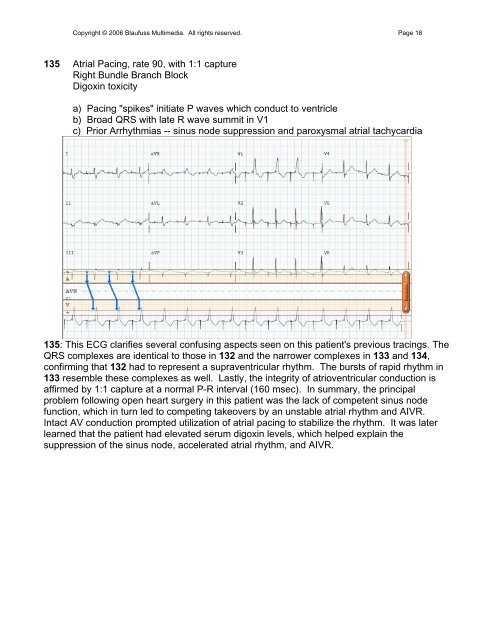002 Sinus Rhythm, atrial rate 90 Mobitz II - Blaufuss Multimedia
002 Sinus Rhythm, atrial rate 90 Mobitz II - Blaufuss Multimedia
002 Sinus Rhythm, atrial rate 90 Mobitz II - Blaufuss Multimedia
You also want an ePaper? Increase the reach of your titles
YUMPU automatically turns print PDFs into web optimized ePapers that Google loves.
Copyright © 2006 <strong>Blaufuss</strong> <strong>Multimedia</strong>. All rights reserved. Page 18<br />
135 Atrial Pacing, <strong>rate</strong> <strong>90</strong>, with 1:1 capture<br />
Right Bundle Branch Block<br />
Digoxin toxicity<br />
a) Pacing "spikes" initiate P waves which conduct to ventricle<br />
b) Broad QRS with late R wave summit in V1<br />
c) Prior Arrhythmias -- sinus node suppression and paroxysmal <strong>atrial</strong> tachycardia<br />
135: This ECG clarifies several confusing aspects seen on this patient's previous tracings. The<br />
QRS complexes are identical to those in 132 and the narrower complexes in 133 and 134,<br />
confirming that 132 had to represent a supraventricular rhythm. The bursts of rapid rhythm in<br />
133 resemble these complexes as well. Lastly, the integrity of atrioventricular conduction is<br />
affirmed by 1:1 capture at a normal P-R interval (160 msec). In summary, the principal<br />
problem following open heart surgery in this patient was the lack of competent sinus node<br />
function, which in turn led to competing takeovers by an unstable <strong>atrial</strong> rhythm and AIVR.<br />
Intact AV conduction prompted utilization of <strong>atrial</strong> pacing to stabilize the rhythm. It was later<br />
learned that the patient had elevated serum digoxin levels, which helped explain the<br />
suppression of the sinus node, accele<strong>rate</strong>d <strong>atrial</strong> rhythm, and AIVR.


